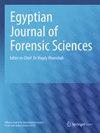Tert-butylhydroquinone prevents cyclophosphamide induce lung toxicity in rats via inhibiting oxidative stress and apoptosis: in vivo and in silico study
IF 1.3
Q3 MEDICINE, LEGAL
引用次数: 0
Abstract
Cyclophosphamide (CP) is a chemotherapeutic and immunosuppressive agent that induces oxidative stress, causing lung tissue damage. The study aims to explore the antioxidant role of tert-butylhydroquinone (TBHQ) in ameliorating CP-induced lung toxicity exhibited as oxidative stress and programmed cell death. Thirty-two adult male rats were allocated randomly into four groups: group 1 (control), group 2 TBHQ 50 mg/kg orally for 14 days, and group 3 single dose of (200 mg/kg, CP, i.p.) on the 9th day. In group 4, TBHQ (50 mg/kg, orally) was provided for 14 days, and (200 mg/kg, CP, i.p.) was administrated on the 9th day. Rats’ body and lung weight were measured. Oxidative stress marker malondialdehyde (MDA) and pulmonary tissue enzymatic antioxidant levels were assessed: glutathione S transferase, catalase, superoxide dismutase, and glutathione peroxidase. Additionally, glutathione level was measured. Assessment of the levels of TNF-α, IL-1β, and IL-6 were done as well as histopathological and immunohistochemistry investigations. Molecular docking studies of the protein structures of p53-MDM2, IL-6, and IL-1β were performed. CP-intoxicated rats demonstrated a significant decline (CAT, GPx, SOD, GST, and GSH) levels and a significant increase in MDA levels. The proinflammatory parameters (TNF-α, IL-6, IL-1ß) were significantly elevated in group 3. The noted biochemical changes, accompanied by histopathological destruction, indicate CP-induced pulmonary tissue injury. TBHQ played a protective role by attenuating most of the aforementioned biochemical alterations and histopathological distortions in rats’ lungs. TBHQ might be utilized as a potential ameliorative agent to inhibit CP-induced pulmonary toxicity via TBHQ’s antioxidant and anti-inflammatory effects.叔丁基对苯二酚通过抑制氧化应激和细胞凋亡预防环磷酰胺诱导的大鼠肺毒性:体内和硅学研究
环磷酰胺(CP)是一种化疗和免疫抑制剂,可诱导氧化应激,造成肺组织损伤。本研究旨在探讨叔丁基对苯二酚(TBHQ)在改善 CP 诱导的肺毒性(氧化应激和程序性细胞死亡)方面的抗氧化作用。将 32 只成年雄性大鼠随机分为四组:第 1 组(对照组)、第 2 组 TBHQ 50 mg/kg 口服 14 天、第 3 组在第 9 天单次给药(200 mg/kg, CP, i.p.)。第 4 组大鼠口服 TBHQ(50 毫克/千克)14 天,第 9 天注射(200 毫克/千克,氯化石蜡,静注)。测量大鼠的体重和肺重量。评估氧化应激标志物丙二醛(MDA)和肺组织酶抗氧化剂水平:谷胱甘肽 S 转移酶、过氧化氢酶、超氧化物歧化酶和谷胱甘肽过氧化物酶。此外,还测量了谷胱甘肽水平。对 TNF-α、IL-1β 和 IL-6 的水平进行了评估,并进行了组织病理学和免疫组化调查。对 p53-MDM2、IL-6 和 IL-1β 的蛋白质结构进行了分子对接研究。氯化石蜡中毒大鼠的 CAT、GPx、SOD、GST 和 GSH 水平显著下降,MDA 水平显著上升。在第 3 组中,促炎症参数(TNF-α、IL-6、IL-1ß)明显升高。 上述生化变化以及组织病理学破坏表明,氯化石蜡诱发了肺组织损伤。TBHQ 通过减轻大鼠肺部的上述生化变化和组织病理学破坏起到了保护作用。通过 TBHQ 的抗氧化和抗炎作用,TBHQ 可作为一种潜在的改善剂来抑制氯化石蜡诱导的肺毒性。
本文章由计算机程序翻译,如有差异,请以英文原文为准。
求助全文
约1分钟内获得全文
求助全文
来源期刊

Egyptian journal of forensic sciences
MEDICINE, LEGAL-
CiteScore
2.00
自引率
0.00%
发文量
51
审稿时长
17 weeks
期刊介绍:
Egyptian Journal of Forensic Sciences, the official publication of The International Association of Law and Forensic Sciences (IALFS), is an open access journal that publishes articles in the forensic sciences, pathology and clinical forensic medicine and its related specialities. The journal carries classic reviews, case studies, original research, hypotheses and learning points, offering critical analysis and scientific appraisal.
 求助内容:
求助内容: 应助结果提醒方式:
应助结果提醒方式:


